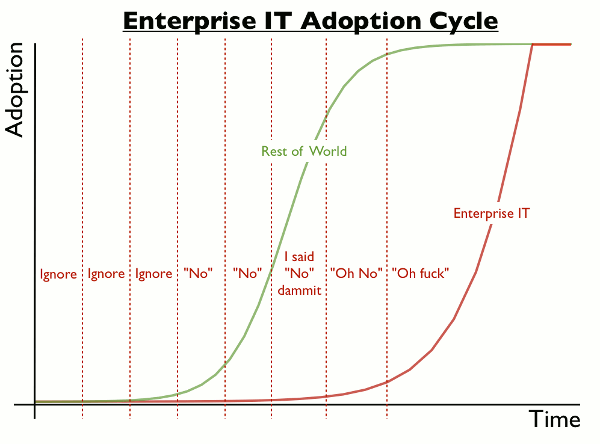Broadly speaking, sales operations is the setting of sales targets, territories and forecasts using data-backed insights. Increasing numbers of companies are staking a profound new interest in sales operations.
Numbers of functional sales operations departments in companies around the globe are on the rise. Once almost exclusively outsourced to consultants, internal sales operations specialists are now in high demand.
Much has changed in a very short time. It's as good a time as any to stop and ask an age-old question: How did we get here? And, for that matter: Where are we going?
Fortunately, the main evolutionary forces behind the emergence of sales operations aren't hard to spot. In fact, they all interconnected with one another. The convergence of 5 elements has created a "Perfect Storm" that precipitated the rise of sales operations, and continues to clear a path for its future growth.
So what's behind the rise of sales operations? We set forth 5 factors and analyze what they signify about the sales organization of the future.
The Origins of Sales Operations
At its essence, the dramatic rise of sales ops is the result of a collision point between 5 greater industry trends. We'll investigate each trend, then look into our Crystal Ball to forecast what the near future holds for sales operations, in particular for the organizations investing in a functional sales operations department. The 5 factors behind the rise of sales operations, respectively, are the emergence of:
- Enterprise Technology
- Data Analytics
- Inside Sales
- Millennials
- Sales-Marketing Alignment
Exploration of each factor leads to excellent insights into the utility, challenges and potential of sales operations as a core business function.
Sales Operations Foundation #1. Techology
Let's get the most obvious sales operations driver out of the way first: Enterprise Technology.
At the turn of the century, SaaS as we know it didn't truly exist. Salesforce.com wasn't even a year old. During the intervening 15 years, we reached a tipping point where enterprise technology began permeating the commercial landscape.
Look inside any B2B sales team for a mid-market or enterprise company, and you'll find a CRM. Look inside their marketing team, and you'll find a marketing automation platform. And I'm starting to wonder whether Slack's very coding causes a phenomena in users resembling chemical dependency.

Everyone is drunk on SaaS. That's great news for sales operations and the flash point for sales operations' sudden vitality as a living, breathing part of more commercial enterprises.
Many enterprises now have a dedicated tech interloper on their sales team-- the Director of Sales Operations.
Sales Operations Pillar #2. Data Analytics
A Harvard Business Review article entitled The New Science of Sales Force Productivity and published in 2006 serves as a harbinger. What's since transpired is nothing short of a data analytics arms race in every business sector. Sales operations is an engine powered by data analytics, an energy source that's growing more potent by the day. And as horsepower gets added, sales operations will take on an increasing level of importance in the commercial enterprise.

If enterprise technology is the father of sales operations, data analytics is its mother. Enterprise technologies source the data that fuels sales operations, but that data first must be transformed into something digestible, accomplished via data analytics. The better the analytics, the more capacity sales operations has to make accurate, powerful data-driven decisions.
Sales Operations Pillar #3. Inside Sales
Companies are increasingly moving toward an inside sales model and away from the field sales model. This makes processes, key performance metrics and benchmarks simultaneously easier and more critical to define and track. Guess who's a prime benefactor this major industry trend? Sales operations.

The prototypical inside sales model places heavy focus on the repeatable activities (outbound dials, emails, leads touched, and so forth) in its sales process. That makes the data much less unwieldy, and the path from activities to objectives much easier to track. In other words, the perfect ecosystem for a committed sales operations specialist to thrive.
Sales Operations Pillar #4. Millennials
For many sales organizations, the more to inside sales is part of an overarching shift toward lean operations. These same budget-conscious organizations are now focusing recruitment efforts on fresh crops of Millennial college graduates, with zero professional experience, much smaller salary requirements and an affinity for technology.

Bridge Group President and Chief Strategist Trish Bertuzzi has some great insight on this point. Check her comment in our article, How Sales Enablement Impacts the War for Talent.
"I think it is important to note that the underlying reason ramp time is increasing so significantly is that SaaS companies are trending to hiring more and more recent college grads. This is primarily due to the lack of experienced talent in the market as well as the desire to keep selling costs low. Having said that, this necessitates a shift in how sales enablement creates onboarding programs. More time must be invested in learning industry, buyer and business issues prior to product and basic sales skills. Those that figure this out are those that win." Trish Bertuzzi
As Trish notes, lack of experience has effectuated longer ramp times, which in turn takes a bite out of new hire ROI in Year 1. Again, a problem ripe for solving using sales operations. More importantly, however, the emergence of Millennials brings a new crop of employees to the sales force, ones more inclined to be readily accepting of technological approaches to tracking and driving performance.
Sales Operations Pillar #5. Alignment
Finally, the growing emphasis on aligning sales, marketing and customer success lends greater weight to sales operations. Still emerging as a point of focus in B2B sales companies, sales-marketing alignment has become the most recent driver of sales operations.

Tethering sales and marketing often involves fusing different technology systems (ex. Salesforce and Pardot) and using data as the arbiter of best ways that marketing can impact sales and vice versa.
As explored by Docurated VP of Marketing Fergal Glynn and me in The Sales-Marketing Alignment Playbook, the very nature of sales-marketing alignment calls for sales operations schematics. For illumination into how that works, check out this eBook excerpt on Sales Hacker. While somewhat less pervasive than the other market forces listed, sales-marketing alignment appears poised to gain influence as an impetus for adopting a functional sales operations department.
Forecasting the Future of Sales Operations
As one might guess, we're bullish on what the future holds for sales operations. Each trend that fueled its initial emergence continues to gain momentum. The SaaS gold rush continues to flourish, creating an onrush of increasingly powerful, sophisticated and versatile data sources into commercial enterprise. Its value long-proven, more aggressive technology adoption is beginning to take place across the business sphere at large.

Likewise, data analytics is on a massive upward trajectory. Last May, MIT-Sloan published a report entitled The Analytics Mandate that presents some pretty staggering numbers in terms of demand. Barring another tech bubble collapse, that will continue. And with market demand as high as it is for innovative technology, and especially smarter data analytics, sales ops would seem relatively shielded from the fallout were a collapse to occur.
Inside sales, for its part, seems almost bulletproof in its growth. Many companies making the switch from field sales to inside sales will see sales operations as a necessary counterpart to their organizational change. A package deal, so to speak. Millennials, and their record-breaking student loan debt (sighing), aren't going anywhere. Enough said. And lastly, demand for sales-marketing-support alignment will continue to provide a powerful impetus for its implementers to co-adopt adopt sales operations as a means of quality assurance. Another package deal.
What all this mean? Sales Operations is just now starting to crest. And for potential adopters of sales operations, the time to invest in a functional sales operations department is now.
Drive Sales Operations with Ambition
Ambition is a sales management platform that syncs every department, data source, and performance metric in your organization on one system.
Ambition enhances clarity around key sales performance metrics. Ambition's drag-and-drop interface lets non-technical sales leaders create custom sales scorecards, contests, reports, and TV leaderboards with live Salesforce data.
Ambition is endorsed by Harvard Business Review, AA-ISP (the Global Inside Sales Organization), and USA Today as a proven solution for managing sales teams and tracking sales activity. Visit our AppExchange page and hear from our clients below
Watch Testimonials:
- FiveStars: Adam Wall. Sr. Manager of Sales Operations .
- Filemaker: Brad Freitag. Vice-President of Worldwide Sales.
- Outreach: Mark Kosoglow. Vice-President of Sales.
- Cell Marque: Lauren Hopson. Director of Sales & Marketing.
- Access America Transport: Ted Alling. Chief Executive Officer.
Watch Product Walkthroughs:
- ChowNow. Led by Vice-President of Sales, Drew Woodcock.
- Outreach. Led by Sales Development Manager, Alex Lynn.
- AMX Logistics. Led by Executive Vice-President ,Jared Moore.
Read Case Studies:
- Clayton Homes: HBR finds triple-digit growth in 3 sales efficiency metrics.
- Coyote Logistics: Monthly revenue per broker grew $525 in 6 months.
- Peek: Monthly sales activity volume grew 142% in 6 months.
- Vorsight: Monthly sales conversations grew 300% in 6 months.
Contact us to learn how Ambition can impact your sales organization today.
 Back
Back



